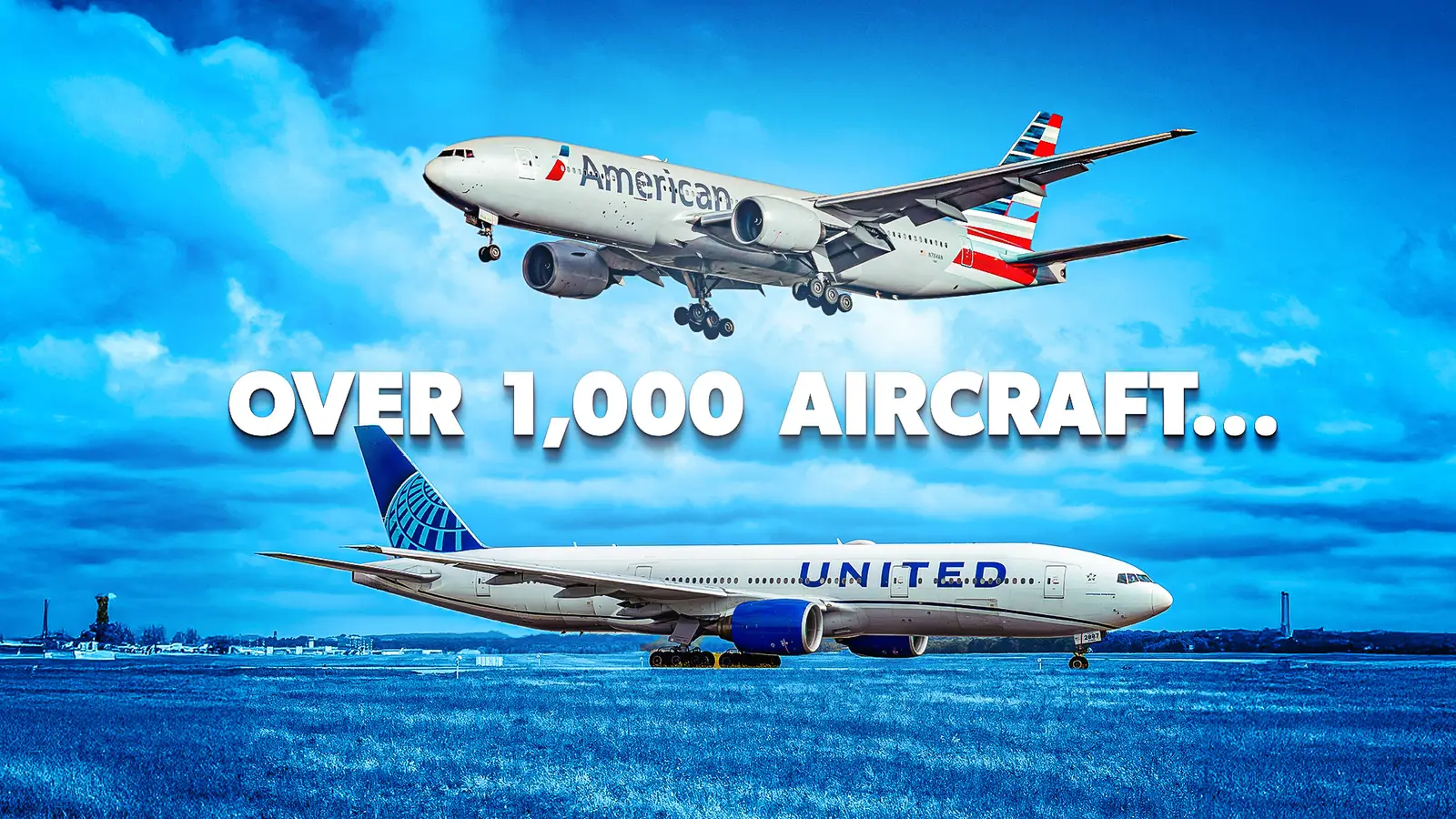
American Airlines and United Airlines are two of the largest and most influential carriers in the world, both playing a dominant role in the US and global aviation markets. The two airlines are locked in a long-running rivalry that spans routes, hubs, and fleets.
In this article, we will use data from ch-aviation to compare the current fleet sizes of American Airlines and United Airlines to determine which carrier operates the larger fleet. We’ll also take a closer look at their future aircraft orders to assess whether that ranking is likely to change in the coming years.
American Airlines’ Airbus Fleet
Let’s start by looking at American Airlines’ fleet of 483 Airbus aircraft. The oneworld carrier operates one of the largest Airbus fleets in the world, forming a critical part of its operations across the US, and increasingly, select international routes. As of 2025, Airbus aircraft make up nearly half of American’s mainline fleet.
The Airbus A321 is the backbone of American Airlines’ narrowbody operations. The airline operates more than 200 A321ceos and over 80 A321neos, making it the largest operator of the A321 family worldwide. The A321’s combination of relatively high passenger capacity and fuel efficiency makes it ideally suited for American’s high-frequency operations in congested markets.
Looking to the future, American Airlines is preparing to introduce almost 50 Airbus A321XLRs to its fleet. With a range of over 4,700 nautical miles, the game-changing A321XLR will enable the carrier to launch new long-haul narrowbody routes, such as transatlantic flights to secondary European cities or South American destinations, with lower operating costs compared to traditional widebody jets.
The Airbus aircraft currently operated by American Airlines are outlined in the table below:
American Airlines’ Boeing Fleet
American Airlines’ Boeing fleet plays a vital role in supporting the airline’s high-density domestic routes and long-haul international services. The carrier operates a wide range of Boeing aircraft, including both narrowbody and widebody models, which together make up just over half of its mainline fleet.
At the heart of American Airlines’ Boeing narrowbody fleet is the 737 family, particularly the 737-800 and the newer Boeing 737 MAX 8. The 737-800 continues to be a workhorse for the carrier, and is deployed extensively on domestic routes and to destinations in Mexico, Canada, and the Caribbean. In recent years, American Airlines has also been growing its fleet of 737 MAX 8s, which offer improved fuel efficiency, lower emissions, and a quieter, more modern cabin. As aircraft deliveries continue, the 737 MAX series (including both the 737 MAX 8 and the larger 737 MAX 10) will eventually replace the carrier’s older 737-800s.
When it comes to American Airlines’ Boeing widebody fleet, the carrier currently operates exactly 67 of both the 777 and 787 series of aircraft. The Boeing 777-300ER is American Airlines’ aircraft with the highest capacity, capable of accommodating up to 330 passengers in a three-class configuration – 70 in business class, 44 in premium economy, and 216 in economy class. Data from Flightradar24 shows that the carrier deploys its 777-300ERs on some of its most popular long-haul routes, including New York John F. Kennedy International Airport (JFK) to London Heathrow Airport (LHR), Miami International Airport (MIA) to São Paulo Guarulhos International Airport (GRU), and Los Angeles International Airport (LAX) to Sydney Airport (SYD).
American Airlines has slightly more Boeing aircraft in its fleet than Airbus aircraft – 516 vs 483.
About American Airlines
American Airlines is the world’s largest airline by scheduled passengers carried, transporting an incredible 248 million passengers in 2024. The carrier is one of the founding members of the oneworld alliance, together with British Airways, Cathay Pacific, Qantas, and Canadian Airlines.
American Airlines’ headquarters is located in Fort Worth, Texas, and the carrier has a number of significant hubs strategically located across the US, including Dallas/Fort Worth International Airport (DFW), Charlotte Douglas International Airport (CLT), Miami International Airport (MIA), Phoenix Sky Harbor International Airport (PHX), and Los Angeles International Airport (LAX). Today, the average age of American Airlines’ fleet is just over 14 years old. Now let’s take a look at United Airlines’ fleet to see how it compares to that of its closest rival.
United Airlines’ Airbus Fleet
United Airlines operates a much smaller Airbus fleet than that of American Airlines, with a total of 199 aircraft spread across three aircraft types – the A319, A320, and A321neo. These aircraft are frequently used on domestic routes and shorter international flights, offering flexibility and efficiency for high-frequency schedules and routes with moderate demand.
Upon delivery, the Airbus A321XLR will transform United Airlines’ ability to serve long-haul routes that do not require the capacity of a widebody aircraft. With greater fuel efficiency and reduced carbon emissions, these aircraft will also help the Star Alliance carrier to achieve its ambitious sustainability goals. United Airlines also has 45 A350-900s on order, which will be the carrier’s only widebody Airbus aircraft.
This growing Airbus presence reflects United Airlines’ strategic move to a more versatile and economical fleet, and as deliveries ramp up through the second half of the decade, the European manufacturer will play a more prominent role in shaping the carrier’s future network.
United Airlines’ Boeing Fleet
Despite the growing number of Airbus aircraft, United Airlines’ fleet is still very much dominated by Boeing. The carrier operates a staggering 16 different types of aircraft, ranging in size from the 737-700 to the 777-300ER. The latter has a capacity of up to 350 passengers in a three-class configuration – 60 in business class, 24 in premium economy, and 266 in economy class.
Over the next few years, United Airlines will replace its older, less efficient aircraft, such as the Boeing 737-700, 757-200, 767-300ER, and 767-400ER, with newer models (such as the 737 MAX series and the 787-9) that offer lower operational costs and greater sustainability credentials.
Taking the Boeing 767-300ER as an example, in recent days, United Airlines has deployed the aircraft to a variety of transatlantic destinations from its hub at Newark Liberty International Airport (EWR), including to London Heathrow Airport (LHR), Amsterdam Schiphol Airport (AMS), and Naples International Airport (NAP).
About United Airlines
United Airlines was established in 1926, and has since grown substantially through mergers and innovation to become a cornerstone of the airline industry. Today, the Star Alliance carrier operates a vast network covering domestic and transcontinental routes, as well as over 130 international destinations in more than 65 countries.
United Airlines operates from a large number of hubs across the US, including Newark Liberty International Airport (EWR), which acts as the carrier’s primary transatlantic gateway, and San Francisco International Airport (SFO), which sees the bulk of the airline’s transpacific routes. The latter has seen significant expansion from United Airlines over recent years, with the carrier launching flights to Adelaide Airport (ADL) in Australia, Bangkok Suvarnabhumi International Airport (BKK) in Thailand, Ho Chi Minh City Tan Son Nhat International Airport (SGN) in Vietnam, and adding a second daily service to Manila Ninoy Aquino International Airport (MNL) in the Philippines.
Which Airline Has The Largest Fleet?
When looking at the data, there is one clear winner – United Airlines currently has the larger fleet of the two carriers, with 1,048 aircraft compared to American Airlines’ 999. It looks set to stay that way for the foreseeable future, given that United Airlines has over 300 more aircraft on order than its oneworld rival.



